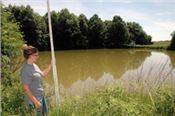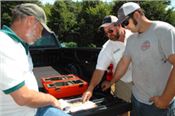|
MU Extension, NRCS Partner To Help Farmers Convert Cropland To Pasture

NRCS district technician Cassie Lenzenhuber was part of the team that
evaluated Matthew Spiers' pond for gravity-fed tanks.
WELLSVILLE, MO.
Matthew Spiers wants to convert cropland to pastureland for grazing. Through a joint effort by University of Missouri Extension and USDA’s Natural Resources Conservation Service (NRCS), Spiers plans to build a rotational grazing system so he won’t have to rent more pastureland to expand his cattle herd.
MU Extension agronomist Rusty Lee says the Spiers project is a “start from scratch” opportunity for the agencies to work together to help a young farmer. Collaboration brings more resources and better results than working separately, says Lee.
The new opportunity begins with a young farmer and an old family farm. Spiers lives on a Century Farm, a designation given by MU Extension to farms owned and lived on by members of the same family for more than 100 years.
He spent summers on the farm with his grandfather and always dreamed of leaving Belleville, Ill., to return to the farm. “I’m that rare city kid that wants to farm,” he says.
He rents about 500 acres of pasture and cropland from his 89-year-old grandfather. He also does custom hay baling and combining.
Spiers attended several workshops sponsored by NRCS and MU Extension before making the first visit to the Montgomery County NRCS office.
Converting cropland to pastureland is no simple task, says Lee. It is a multiyear process that requires patience, money and sound technical advice.
“Deciding you want to change from row crops to perennial grass is not a decision to be made in 30 minutes,” says Rob Kallenbach, an MU forage specialist and assistant dean.
There are many considerations that affect long-term success, including availability of water, fencing, good forage, type of grazing system, shade and sustainability. Together, MU Extension and NRCS provide technical expertise across this whole gamut of topics.
Spiers plans to use a rotational grazing system designed by MU Extension and NRCS. By letting cows move from paddock to paddock, the system prevents overgrazing and allows enhanced root development. This, in turn, makes pastures more resilient to drought and enables faster regrowth.
Studies show that rotational grazing doubles the amount of forage utilization, says NRCS resource conservationist David Korman. Cows eat only 30 percent of available forages when grazing on an open field. They eat 60 percent when moved regularly through smaller paddocks, he says.
Water availability for cattle was key to Spiers’ conversion. Korman, Lee and NRCS district technician Cassie Lenzenhuber evaluated ponds for gravity-fed tanks. They found the pond was insufficient to meet the herd’s needs. They recommended that Spiers lay additional water lines at strategic points to pump in rural water to individual grazing paddocks. This protects the herd with a safe, dependable water supply in times of drought. They suggested locations for freeze-proof water troughs and looked at shade and shelter options. They also recommended fencing systems for the paddocks.
Kallenbach says one of the first things producers need to figure out is what kind of forage to plant and how it contributes to the whole farm system. Regional MU Extension specialists share research on pasture diversity and forages to lengthen the grazing season for years to come.
Converting cropland back to pasture also offers the opportunity to establish nontoxic novel endophyte varieties faster and more easily than trying to go from one perennial grass to another, says Lee.
Productive pastures begin with healthy soil. Spiers followed Lee’s advice to test the soil for lime and fertilizer recommendations. Soil testing should be done early because limestone can take time to break down and change soil pH, Kallenbach says.
Korman says Spiers will receive cost-share incentives to follow NRCS recommendations. The incentives promote conservation measures that farmers and livestock producers might not otherwise put into place due to cost.
Korman says NRCS awards cost-share dollars to applicants based on the “greatest environmental benefit achieved with the least amount of dollars.”
Lee says this long-term partnership between MU Extension and NRCS offers farmers one-to-one advice on best management practices for modern farming. In addition, MU and NRCS work with local soil and water conservation districts to provide on-farm cost-share programs to help landowners adopt conservation practices that protect the soil and improve water quality. ∆

NRCS resource conservationist David Korman, left, and MU Extension agronomist
Rusty Lee, center, work with Matthew Spiers, right, to convert cropland to pastureland on Spiers' Wellsville farm.
|
|